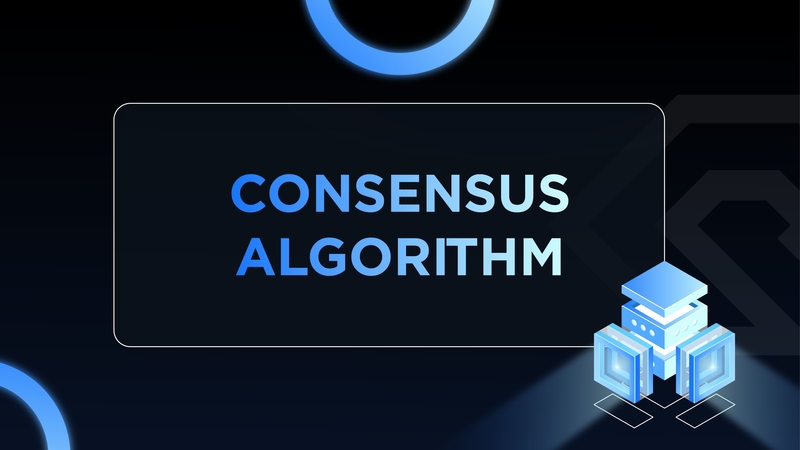Consensus is a crucial element in Blockchain systems, ensuring that all transactions are verified and agreed upon by nodes in the network without the need for intervention from a central authority. In this article, we will explore “What is Consensus?”, how it works, and some of the most popular algorithms.
What is Consensus?
Consensus in Blockchain refers to the process by which nodes in the network achieve agreement on transactions without the involvement of a central authority. This means that no single entity controls or manages the transactions on the Blockchain. Instead, the distributed system of nodes must agree and validate transactions through a pre-established consensus mechanism.
In traditional systems such as banking, when a transaction occurs, a central authority or institution is responsible for verifying and updating the transaction in the database. However, in Blockchain, as there is no central organization, transaction verification and updates rely on the consensus of the participants in the network. Therefore, Consensus not only ensures the accuracy of transactions but also helps prevent fraud and protects data from unauthorized interference.

The importance of Consensus in Blockchain lies in the trust it fosters among nodes in the network. In a decentralized environment, where no party has control over the system, Consensus provides a mechanism for nodes to agree on changes and transactions without depending on an external authority. This is the key factor that enables Blockchain to achieve transparency, security, and resistance to tampering, something centralized systems cannot offer.
How does Consensus work?
The Consensus mechanism operates through a series of steps that the nodes in a Blockchain network must follow to reach an agreement on a transaction. This process is designed to ensure that all transactions are validated accurately and transparently, while preventing illegal alterations or fraud. Once all nodes agree on the validity of a transaction, it is recorded on the Blockchain and cannot be altered.
To understand this better, imagine a meeting between all the nodes in the Blockchain network. Each node makes a decision on whether to validate the transaction or not. For consensus to be achieved, not all nodes need to agree, but a certain percentage must reach an agreement for the transaction to be validated. This percentage depends on the type of consensus mechanism the network uses (for example, 51% in Proof of Work).

Transactions are grouped into blocks, and these blocks are validated by the nodes in the network. To add a transaction to the Blockchain, the nodes need to verify its validity. Consensus algorithms such as Proof of Work (PoW) or Proof of Stake (PoS) help determine who will validate the transaction and contribute to maintaining the network’s stability.
A critical aspect of this process is preventing attacks like the 51% attack, where a group of nodes attempts to control the consensus process and alter transactions on the Blockchain. Therefore, Consensus not only ensures accuracy but also helps protect the network from external threats.
Popular Consensus algorithms
There are several types of Consensus algorithms used in Blockchain systems. Each algorithm has its unique characteristics and is suitable for different types of networks. Here are some of the most widely used Consensus algorithms:
Proof of Work (PoW)
Proof of Work (PoW) is the first and most well-known Consensus algorithm, used in Bitcoin and many other cryptocurrencies. PoW requires miners to solve complex mathematical problems to validate and record transactions on the Blockchain. This process is called “mining” and requires significant computational resources and electricity.

- How it works: In PoW, miners compete to solve a mathematical problem. The first one to solve the problem receives a reward, usually in the form of cryptocurrency (e.g., Bitcoin), and the right to add a transaction block to the Blockchain.
Advantages
- High security: PoW provides a high level of security, as to alter any data on the Blockchain, an attacker would need to control more than 51% of the network’s computing power, which is extremely difficult and costly.
- Proven success: PoW has been tested and proven to be highly effective in Bitcoin, creating a truly decentralized network.
Disadvantages
- Energy consumption: PoW requires a large amount of energy and computational resources, leading to high electricity consumption. This can have a negative environmental impact.
- Slow Transaction Speed: PoW can also cause delays in transaction verification, as each transaction needs to be processed by miners for an extended period.
Proof of Stake (PoS)
Proof of Stake (PoS) is an alternative solution to PoW, designed to address the energy consumption and slow transaction speeds of PoW. In PoS, instead of requiring miners to solve complex problems, network participants must stake (lock) a certain amount of cryptocurrency to become validators of transactions.

- How it works: Network participants (validators) must stake cryptocurrency on the network. These validators are then randomly selected to verify transactions. Each time they successfully verify a transaction, they are rewarded, usually with transaction fees.
Advantages
- Energy efficiency: PoS does not require solving complex mathematical problems like PoW, significantly reducing energy consumption.
- Faster transaction speeds: PoS speeds up transaction processing because it doesn’t require the complex calculations needed in PoW.
- Better scalability: PoS reduces the burden on the system, making it easier for the Blockchain to scale.
Disadvantages
- Asset centralization: In PoS, those who hold more cryptocurrency may have more power in validating transactions, leading to a centralization of control among a few participants.
- Potential vulnerability in staking: If a participant stakes too much, it could cause an unfair distribution of power and reduce the decentralization of the network.
Delegated Proof of Stake (DPoS)
Delegated Proof of Stake (DPoS) is an enhanced version of PoS, where cryptocurrency holders vote for delegates to validate transactions on their behalf. This approach aims to improve transaction speed and reduce power centralization.

- How it works: In DPoS, cryptocurrency holders vote for delegates (usually reputable organizations or individuals) to validate transactions on the Blockchain. These delegates represent the community and are responsible for maintaining the network’s security and efficiency.
Advantages
- Faster transaction speed: DPoS improves transaction speed by reducing the number of participants in the consensus process.
- Lower transaction fees: Since only a few delegates validate transactions, transaction fees are lower compared to PoW and PoS.
- Better scalability: DPoS offers greater scalability, making it an ideal solution for large-scale Blockchain projects.
Disadvantages
- Power centralization: While DPoS attempts to improve decentralization, power remains concentrated in the hands of a few delegates, which can reduce transparency and lead to potential corruption.
- Ongoing voting requirements: DPoS requires continuous voting from the community, which may reduce system stability.
Proof of Authority (PoA)
Proof of Authority (PoA) is a consensus algorithm primarily used in private or permissioned Blockchain networks. In PoA, validators are chosen based on their reputation or authority rather than the amount of cryptocurrency they stake, as in PoS.

- How it works: In PoA, validators must have a certain level of reputation or authority to become “validators.” These validators are responsible for verifying transactions and creating new blocks.
Advantages
- Fast transaction validation: PoA helps transactions get validated quickly, making it ideal for enterprise applications or private Blockchain networks.
- Low cost: PoA does not require significant computational resources or electricity, reducing transaction costs.
Disadvantages
- Lack of decentralization: Since validators are selected based on reputation, PoA does not achieve the same level of decentralization as other algorithms.
- Trust issues: The reliability of PoA depends on whether validators perform their duties honestly.
Practical Byzantine Fault Tolerance (PBFT)
Practical Byzantine Fault Tolerance (PBFT) is a consensus algorithm used in highly distributed Blockchain systems that require high accuracy. PBFT is designed to ensure that the Blockchain network can continue to function even when some nodes are uncooperative or attacked.

- How it works: In PBFT, nodes in the network must reach consensus on transactions. The nodes go through three steps: confirming the transaction, sending information to other nodes, and waiting for confirmation from the other nodes.
Advantages
- Resistance to Byzantine Attacks: PBFT is effective in maintaining the stability and security of the system, even if some nodes are faulty or uncooperative.
- High speed and efficiency: PBFT helps reduce latency and speeds up transaction processing in the Blockchain network.
Disadvantages
- High resource requirements: PBFT requires a lot of computational resources and bandwidth to maintain consensus among the nodes.
- Limited scalability: PBFT is not suitable for large-scale Blockchain networks.
So, what is Consensus? It is a core element in the Blockchain system, ensuring that transactions are validated safely and transparently without the need for central authority intervention. Its popular algorithms each have their own advantages and disadvantages, directly influencing transaction speed, security, and the efficiency of the Blockchain network. Choosing the right algorithm will determine the success of a Blockchain project. With the continuous development of technology, new Consensus algorithms are being researched and implemented to further enhance the performance and security of Blockchain systems in the future.
We hope that this article has helped you understand “What is Consensus?” Be sure to follow Forexmarketsolutions for more valuable information and insights every day.
